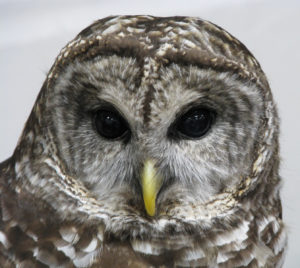Whoosh! A clump of feathers shot out of the predawn blue the other morning and landed on a birdfeeder ten feet from the kitchen window. I nearly dropped my coffee cup. The bird stared right at me with dark eyes in a pale face that was both familiar and alien. A barred owl.
She pounced and missed a red squirrel and then swooped up into a spruce tree at the edge of the yard. Her gray-brown and cream plumage blended perfectly with the bark. Six chickadees dive-bombed her, but she didn’t budge.
Neither did I. Still in my pajamas, I sat on the kitchen counter and watched her through binoculars most of the morning. When she finally flew off into the woods, I grabbed my field guides and books to learn more about this cool and otherworldly bird (never mind that I was on a deadline for something else). Here are some things I discovered:
Why the creepy stare? Owls can blink, but they can’t move their eyes, which are tubular and shaped something like telescopes.
Can barred owls turn their heads all the way around? No, but they can turn their heads more than 270 degrees in each direction, thanks to special neck vertebrae.
What do barred owls eat? Mostly rodents like mice, voles and squirrels, along with birds as big as a grouse, plus invertebrates, amphibians, and reptiles. The owl I saw probably didn’t attack the chickadees because owls prefer to swoop down on prey from a hunting perch rather than snatching them from the air.
Where do barred owls live? In mixed woods, often near water, in the eastern half of the U.S. and across forested regions of Canada. They prefer unbroken tracts of mature trees.
Do barred owls migrate? No, they are homebodies! If you see a barred owl, you are most likely in its home territory, which is usually only a few miles square.
“Who cooks for you?” That’s the barred owl’s call, which I always feel lucky to hear in the middle of the night!
Where do barred owls nest? Usually in tree cavities between 20 and 40 feet above the ground.
Late in the afternoon, the owl returned to our yard. It landed on a fencepost in the garden, opened its mouth and hacked up a pellet—a packet of undigested fur and bones. A few minutes later it flew away and I raced outside to find the pellet. It’s drying on the kitchen windowsill and I can’t wait to dissect to try to figure out what the owl had for lunch!

